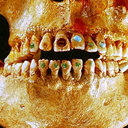Evaluation of the Anticonvulsant Activity of the Leaves of Glycyrrhiza glabra var. glandulifera Grown in Iran, as a Possible Renewable Source for Anticonvulsant Compounds.
Palabras clave
Abstracto
A review of the publications in traditional medicine indicates that the root of Glycyrrhiza glabra L., Fabaceae, is recommended for treatment of epilepsy. As a renewable source, the leaves of G. glabra var. glandulifera growing in Iran were examined for possible anticonvulsant activity. The anticonvulsant activity of the leaves' ethanol extract and dichloromethane, f1, n-Hexane, f1A, and methanol, f1B, fractions were evaluated intraperitoneally in mice using maximal electroshock (MES) and pentylenetetrazol (PTZ) seizure tests. Acute toxicity of the extract and the fractions were also assessed. Phytochemical screening of the extract and the fractions for their active constituents was also carried out by thin layer chromatography and various chemical reagents. The extract and the fractions showed anticonvulsant effect in PTZ test. The ED50 value of 2.11 g/Kg and 1.30 g/Kg was obtained for the crude extract and f1 fraction, respectively. The LD50 value of 3.0 g/Kg was found for the extract. Triterpenes/sterols, alkaloids, flavonoids, anthraquinones and tannins were present in the extract and fractions. Triterpenes and anthraquinones were the highest in the extract, while triterpenes and tannins were prevailing in f1 fraction. The anticonvulsant activity of the extract and f1 fraction could be mainly attributed to the compounds of triterpenes/sterols class present in the leaves of the plant. The therapeutic index of the leaves' extract was narrow and in this regard it has low anticonvulsant potential. Evaluation of the possible anticonvulsant activity of the leaves of the other varieties of G. glabra grown in Iran (e.g., var. violacea) is suggested.


